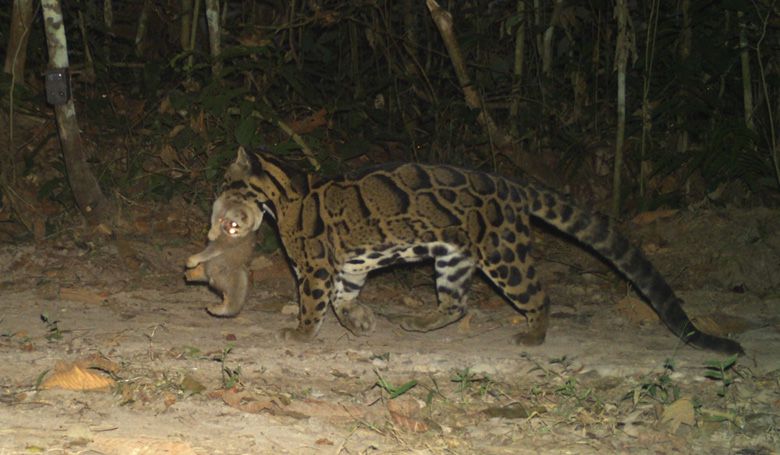Guwahati, May 15: In Assam’s Dehing Patkai National Park—India’s only rainforest—a rare and elusive predator was caught in the act. Under the cloak of night, a camera trap clicked at precisely 20:58 on December 7, 2024, capturing a haunting yet powerful moment: a mainland clouded leopard (Neofelis nebulosa) moving silently along a forest trail, clutching a Bengal slow loris (Nycticebus bengalensis) by the nape.
This image marks the first-ever photographic documentation of a clouded leopard preying on a Bengal slow loris, offering an extraordinary insight into the secretive dietary habits of one of Asia’s most enigmatic big cats.
The study carried out by scientists from Wildlife Institute was published in Journal of Wildlife Science.

Classified as Vulnerable by the IUCN and protected under CITES Appendix I, the clouded leopard is a ghost of the forest—rarely seen, rarely understood. Its elusive nature has long made it difficult for researchers to determine its favored prey. Past studies, such as scat analysis in Thailand, hinted at its primate predation, mistakenly citing the Bengal slow loris when referring to its congener, the Greater slow loris (Nycticebus coucang). But now, with this photographic record, there’s no ambiguity.
The setting of this discovery—a tropical wet evergreen forest with a rich canopy of Dipterocarpus retusus, Mesua ferrea, and Dysoxylum gotadhora—lies just over a kilometer from the nearest tea garden and 2.5 kilometers from human settlement. Here, the clouded leopard thrives in a delicate balance, sharing space with another threatened species: the Bengal slow loris, the only strepsirrhine primate in northeast India, and itself classified as Endangered.
Slow lorises are nocturnal, arboreal, and extraordinarily specialized. Spending nearly 87% of their feeding time on plant exudates, their slow, deliberate movements and predictable foraging routes may make them vulnerable to agile predators like the clouded leopard. Weighing between 850 and 2100 grams, they present a relatively easy target in the dense canopy—especially for a predator as adept at climbing as the clouded leopard.

Clouded leopards have been documented feeding on a wide array of prey, from ungulates and rodents to primates, pangolins, and even domestic animals. But precise data on prey preference remains scarce, particularly within their Indian range. This record adds a vital piece to that puzzle.
“This finding, made through camera trapping, contributes to our understanding of predatory behavior and diet, highlighting the significance of conservation efforts for both species” the authors of the study say.
Also Read: Meghalaya college principals urge NEHU to resolve affiliation issues
Watch
Find latest news from every corner of Northeast India at hubnetwork.in, your online source for breaking news, video coverage.
Also, Follow us on-
Twitter-twitter.com/nemediahub
Youtube channel- www.youtube.com/@NortheastMediaHub2020
Instagram- www.instagram.com/ne_media_hub
Download our app from playstore – Northeast Media Hub





